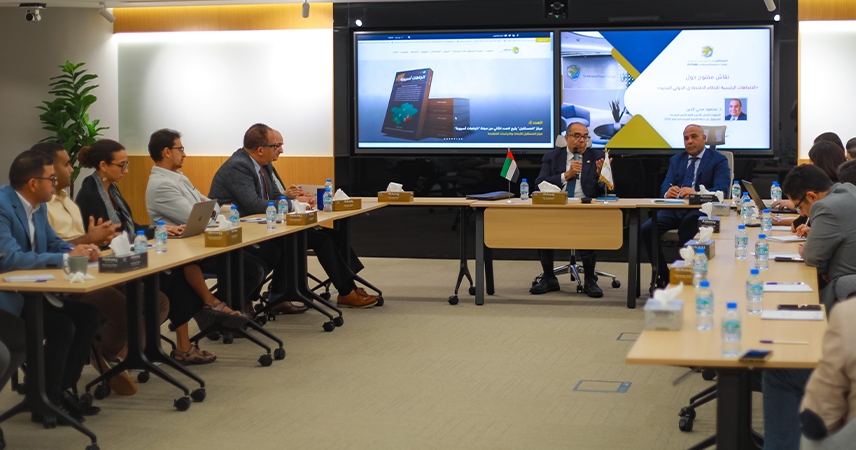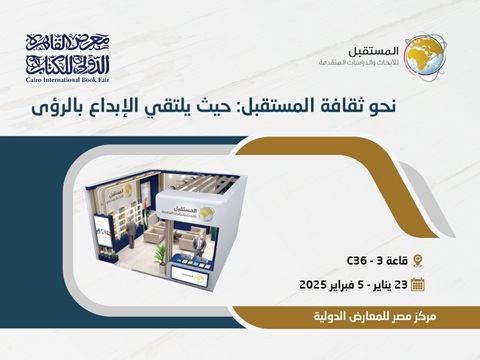On November 1, 2024, the Future Center for Advanced Research and Studies hosted a panel discussion featuring Dr. Mahmoud Mohieldin, the Special Envoy of the United Nations Secretary-General for the 2030 Agenda for Sustainable Development. The event, attended by experts and researchers from the center, focused on exploring the main trends shaping the new international economic order.
During the discussion, Dr. Mohieldin addressed several key issues, providing valuable insights into the global economic landscape. He highlighted the progress made towards achieving the global sustainable development goals and examined the current international economic environment, including the structural and geopolitical challenges it faces. Dr. Mohieldin elaborated on these topics through a series of important points, which he presented as follows:
1- Understanding Economic Phenomena Requires a Comprehensive Approach that Integrates Four Levels of Analysis:
International, regional, national, and local dimensions. Traditionally, economic circles focused primarily on international and national perspectives, overlooking the regional and local aspects. However, interconnecting these four levels provides a more nuanced understanding of the current economic challenges and develops more effective solutions to address them.
2- Participation in Global Decision-Making:
The achievement of global sustainable development goals requires the participation of various economic stakeholders: governments, the private sector, civil society organizations, and the cooperative sector. However, current international economic platforms often fail to adequately represent the interests of all these parties or the diverse range of economic activities. Consequently, discussions within some economic forums tend to reflect the interests of specific parties while excluding others. This imbalance highlights the need for a comprehensive global economic platform that addresses developmental and urgent issues within an inclusive, participatory framework.
3- Global Sustainable Development Goals Gaps:
As the world approaches 2030, it continues to struggle in achieving the goals set forth in the global sustainable development agenda. Recent years have seen squandered opportunities to make significant progress, largely due to geopolitical conflicts, the COVID-19 pandemic, and the resulting challenges imposed on the global economy. Despite these setbacks, some nations have made notable strides. China, for instance, succeeded in eradicating extreme poverty in 2020, demonstrating that progress is possible even in challenging times. The United Nations' "Progress on the Sustainable Development Goals 2023" report paints a sobering picture of the global situation. It indicates that the world remains far from realizing the 2030 Sustainable Development Plan where a mere 17% of the targeted SDGs are on track to be achieved by the target year.
4- Global Crisis of Confidence:
The world is currently grappling with an international crisis of confidence, fueled by a multitude of challenges. These complex issues include climate change, threats to international peace and security, and restrictions on international trade and investment. The cumulative effect of these crises has led to a fragmentation and disintegration of the global economy, exacerbating the development gaps between developing and advanced economies, as well as between developing and emerging economies.
As a result of these ongoing struggles, the past decade can be aptly described as "another lost decade of sustainable development." Consequently, the global community can only aspire to navigate the upcoming decade without encountering these formidable challenges.
5- Uneven Performance of Global Economies:
The global economic landscape has taken a turn for the worse over the past two years, primarily due to a series of unexpected events. These include epidemics, geopolitical conflicts such as the Russian-Ukrainian war and Middle East tensions, as well as international trade disputes. Consequently, the growth trajectory of the global economy and international trade has been severely disrupted.
Economic performance and growth have varied dramatically across different geographical regions, with only a few developed countries maintaining stability. The United States, for instance, is experiencing robust economic growth. In contrast, the European Union is grappling with a substantial economic slowdown, with projected growth rates between 0.5% and 1% for the current year.
Asian economies present a mixed picture. India stands out, reaching the pinnacle of its economic performance, while China strives to reclaim its previous record-breaking growth rates. South American economies, although faring better than their African counterparts, are not immune to fluctuations. They continue to grapple with inconsistent economic performance, largely attributed to the volatility in commodity prices.
6- “Silent Debt” Crisis:
African economies are grappling with a "silent debt" crisis that threatens to impede the region's economic development for the next two decades. This precarious situation stems from both debtors and creditors' reluctance to disclose accurate debt levels. Some African governments, despite the risks involved, are concealing their true debt burdens to maintain access to international financing markets. Simultaneously, international creditors, including pension funds and investment funds, are hesitant to reveal their exposure to these high-risk financing markets. This mutual opacity exacerbates the crisis, creating a cycle of hidden financial vulnerabilities that could have far-reaching consequences for Africa's economic future.
7- Shift in the Global Economic Center of Gravity:
Despite numerous economic challenges, Asia is experiencing significant development and deepening of its economic influence. The global economic center of gravity is steadily moving away from regions near the Atlantic Ocean towards China and India. This shift is primarily driven by demographic changes and substantial GDP growth in these two populous nations.
8- Searching for an Alternative Monetary System:
Global geopolitical tensions have prompted some countries to explore alternatives to the US dollar for settling financial and commercial transactions. While this shift offers certain economic benefits and new financial options, the dollar maintains its position as the most stable and tradable currency worldwide. This dominance stems from several advantages inherent to the US market and economy, including the rule of law, deep capital markets, high liquidity of the dollar, and the ability to settle transactions quickly in US currency.
9- Improving the Global Economy:
Developing and emerging countries must continuously invest in three key areas to drive economic growth: human capital enhancement, technological empowerment and infrastructure development, and strengthening institutional capacity to withstand economic shocks. These critical factors will shape not only their individual economic trajectories but also the future of the global economy. However, realizing these ambitious goals presents a significant challenge, as many developing countries face severe budget constraints and fierce competition for traditional financing channels. Consequently, the pursuit of unconventional financing solutions becomes imperative to overcome these obstacles and fuel sustainable economic progress.
At the conclusion of the panel discussion, Dr. Mohieldin emphasized that the future of the global economic system hinges on progress across several key areas: sustainable development and its financing, international peace and security, youth empowerment, education, technological advancement, and global governance. He noted that while there are encouraging signs in sustainable development and technological empowerment, progress in the other areas remains relatively modest. To summarize the situation, Dr. Mohieldin borrowed an apt phrase, stating that "the results are better than expected, but less than hoped for."



